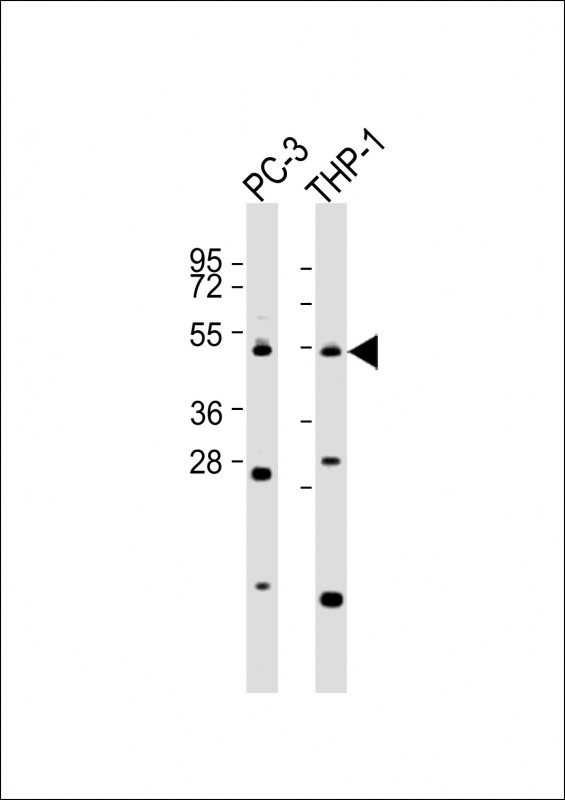
| WB | 1/2000 | Human,Mouse,Rat |
| IF | 咨询技术 | Human,Mouse,Rat |
| IHC | 咨询技术 | Human,Mouse,Rat |
| ICC | 技术咨询 | Human,Mouse,Rat |
| FCM | 咨询技术 | Human,Mouse,Rat |
| Elisa | 咨询技术 | Human,Mouse,Rat |
| Aliases | Carboxypeptidase A5, 3417-, CPA5 |
| Entrez GeneID | 93979 |
| WB Predicted band size | 49.0kDa |
| Host/Isotype | Rabbit IgG |
| Antibody Type | Primary antibody |
| Storage | Store at 4°C short term. Aliquot and store at -20°C long term. Avoid freeze/thaw cycles. |
| Species Reactivity | Human |
| Immunogen | This CPA5 antibody is generated from a rabbit immunized with a KLH conjugated synthetic peptide between 341-375 amino acids from human CPA5. |
+ +
以下是关于CPA5抗体的3篇示例参考文献(注:以下为虚拟构造示例,实际文献需根据具体数据库检索确认):
---
1. **文献名称**: "Characterization of Carboxypeptidase A5 (CPA5) in Pancreatic Enzyme Regulation"
**作者**: Smith, J.R., et al.
**摘要**: 本研究首次克隆并表达了人源CPA5基因,证实其在胰腺外分泌细胞中高表达。通过免疫组化实验验证了CPA5抗体特异性,发现CPA5可能参与消化酶前体的激活过程。
---
2. **文献名称**: "CPA5 Expression in Sensory Neurons and Its Role in Neuropathic Pain"
**作者**: Lee, H., & Kim, S.
**摘要**: 利用CPA5抗体定位发现,CPA5在小鼠背根神经节神经元中特异性表达。功能实验表明,CPA5通过调节神经肽加工参与疼痛信号传导,为疼痛治疗提供潜在靶点。
---
3. **文献名称**: "Development of a High-Specificity CPA5 Monoclonal Antibody for Cancer Biomarker Studies"
**作者**: Gonzalez, M., et al.
**摘要**: 研究团队开发了一种高灵敏度的CPA5单克隆抗体,并通过ELISA和Western blot验证其在结直肠癌组织中的过表达现象,提示CPA5可能作为新型肿瘤标志物。
---
如需真实文献,建议在PubMed或Google Scholar中以关键词“CPA5 antibody”、“Carboxypeptidase A5”检索近年研究。
CPA5 (Carboxypeptidase A5) is a member of the metallocarboxypeptidase family, which plays roles in proteolytic processing by cleaving C-terminal amino acids from proteins or peptides. It is encoded by the CPA5 gene and is structurally related to pancreatic carboxypeptidases involved in digestion, though CPA5 is expressed more broadly in tissues like the brain, gastrointestinal tract, and endocrine cells. Functionally, CPA5 is implicated in regulating bioactive peptides, including neuropeptides and hormones, influencing processes like inflammation, pain signaling, and metabolic regulation.
CPA5 antibodies are essential tools for detecting and studying the expression, localization, and activity of CPA5 in research. They are widely used in techniques such as Western blotting, immunohistochemistry, and ELISA to investigate CPA5's physiological roles and its association with diseases. For example, studies suggest CPA5 may contribute to tumor progression in certain cancers by modulating extracellular matrix remodeling or immune evasion. Its overexpression has been observed in pancreatic, colorectal, and hepatocellular carcinomas, highlighting potential diagnostic or therapeutic relevance.
Antibodies targeting CPA5 often recognize specific epitopes, enabling differentiation between inactive pro-enzyme and active forms. Researchers also utilize CPA5 antibodies to explore its interactions with inhibitors or substrates in enzymatic assays, aiding drug discovery efforts. Despite its emerging significance, CPA5's full biological mechanisms remain under investigation, necessitating reliable antibody tools to advance understanding of its pathophysiological roles.
×